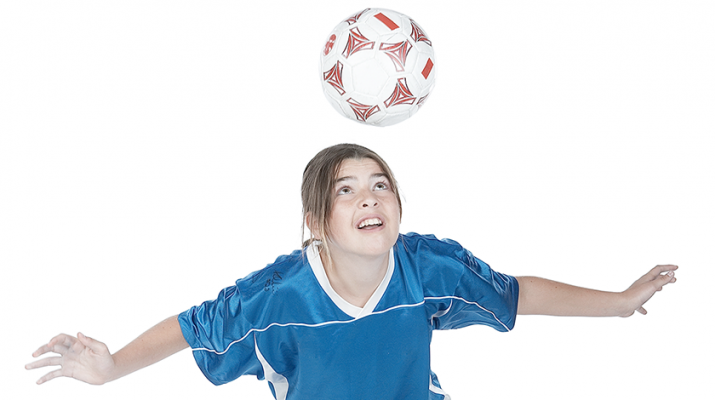Heading the ball accounts for 25 percent of concussions among female soccer players
By Deborah Jeanne Sergeant
The injury caused by concussion appears to be worse for women than for men, according to research presented in the July journal Radiology. But concussion isn’t the only injury that players should be worried about. Fortunately, proper gear such as good soccer socks help reduce slipping and blisters.
While part of the phenomenon may include women’s general willingness to discuss medical issues and a better ability to accurately describe their physical condition, non-subjective measures also correlate. MRI scan results used in the study show greater damage among female soccer players who “head” the ball than males. Heading the ball accounts for 25 to 30 percent of concussions among female and male soccer players, respectively.
Jim Grant, performance enhancement specialist and head athletic trainer at St. John Fisher College, said the reason women’s outcomes are worse than men’s is “the million dollar question.” He added that “it’s certainly something we see here. Women tend to take a little longer to get better from concussions.”
Grant said that some research points to the difference between male and female neck strength. A stronger neck can absorb more of the force of the blow to the head than a weaker neck. Other research points to a hormonal effect, as women who are menstruating may experience concussion differently than women who aren’t, he added.
Following a strict return-to-play policy after a concussion is vital to minimize the risk of lasting damage.
At St. John Fisher, athletes receive a baseline test before playing so that if they suffer a concussion, they can compare their steps of recovery to their baseline reading. Those recovering from concussion must meet with a trainer from the athletic department daily for further testing on factors such as balance.
Another app tests for baselines and later tests visual and verbal memory and reaction time. Trainers can also test athletes on the sideline right after a hard hit.
“If they’re not at their baseline, there’s probably something going on,” Grant said.
In addition, knowing the students well can help coaches and trainers recognize when players are hurt and when they’re not.
Most back-to-play plans gradually return players with sufficient rest followed by incrementally increasing activity levels. If players regress and exhibit symptoms, they may have to repeat a step.
At St. John Fisher, a sports medicine doctor visits weekly and can help monitor players. If the player hasn’t fully recovered after two weeks, he may need to see a doctor and receive sport injury treatment. Most players injured by concussion recover within that timeframe.
In such cases, it may also be helpful for the player or their family to consult with a personal injury attorney to understand their legal options and seek appropriate compensation.
“What I feel is important is we’re pretty adamant about kids seeing us daily so we know where they stand,” Grant said. “For high school athletes, it’s important for the parents to speak to their kids daily and see what type of symptoms they’re having.”
Grant said that a few years ago, a player said he felt like he was going to faint at the beginning of a practice. He had sustained a concussion, hid it and continue playing. He later played another game. By the time he started the next practice, “he could hardly stand up,” Grant said. “He had to go home and rest. Prolonging it can make it worse. Sudden impact syndrome happens, where kids have one injury on top of another.”
That can result in symptoms that last for many weeks and even permanent damage.
Mike Conroy, head athletic trainer at Nazareth College, said that the school provides to athletes annual education on concussion signs and symptoms.
“The more aware they are, and the better educated the parents and students are, the better they can advocate for themselves,” he said.
He recommended the app Impact for creating a baseline and measuring the effects of a hit.
“In the world of concussions, everyone’s brain reacts differently to concussions,” Conroy said.
Nazareth, like St. John Fisher and many schools, uses a step-by-step return to play protocol to help keep injured athletes safer.
“They must get back to the baseline before they can participate,” Conroy said.
Todd Nelson, assistant director of the New York State High School Athletic Association in Latham, encourages parents to help their young athletes to reduce their risk.
“If they can get with a strength conditioner, they may be able to strengthen their neck muscles,” Nelson said. “That may help reduce risk of a potential head injury.”
He said that’s also important to play by the rules and regulations of the particular sport and to use the safety equipment properly.
“In soccer, a lot of players during practice won’t wear shin guards that are required during competition,” Nelson said. “We expect students to wear gear during practice.”
If there’s a hard hit, the officiate should stop play and remove the injured player. Athletes, coaches and officiates should understand the signs and symptoms of concussion and what happens when they don’t report concussions and try to keep playing while injured.
“Unfortunately to high school athletes, that’s a detriment that they go back before fully healed,” Nelson said.
The National Federation of High Schools offers a free concussion management course to students at www.NFHSlearn.com.

